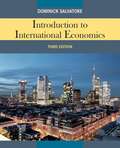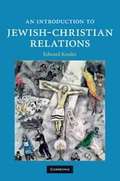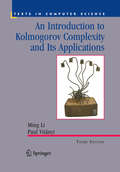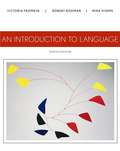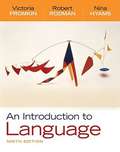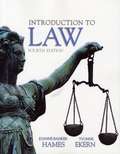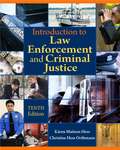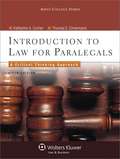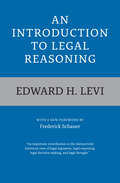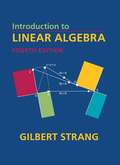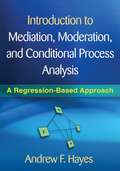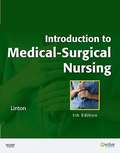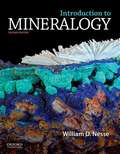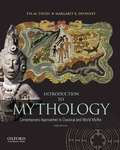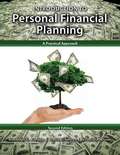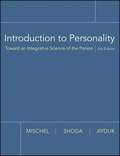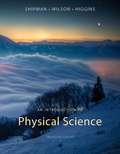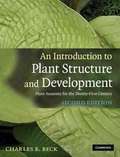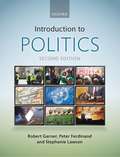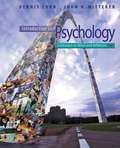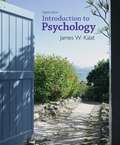- Table View
- List View
Introduction to International Economics (Third Edition)
by Dominick SalvatoreThe aim of this text is to provide the student with an introduction to the field of international economics using many real-world case studies.
An Introduction to Jewish-Christian Relations
by Edward KesslerRelations between Christians and Jews over the past two thousand years have been characterised to a great extent by mutual distrust and by Christian discrimination and violence against Jews. In recent decades, however, a new spirit of dialogue has been emerging, beginning with an awakening among Christians of the Jewish origins of Christianity, and encouraging scholars of both traditions to work together. An Introduction to Jewish-Christian Relations sheds fresh light on this ongoing interfaith encounter, exploring key writings and themes in Jewish-Christian history, from the Jewish context of the New Testament to major events of modern times, including the rise of ecumenism, the horrors of the Holocaust, and the creation of the state of Israel. This accessible theological and historical study also touches on numerous related areas such as Jewish and interfaith studies, philosophy, sociology, cultural studies, international relations and the political sciences.
An Introduction to Kolmogorov Complexity and Its Applications (Texts in Computer Science)
by Ming Li Paul M. B. Vitányi"The book is outstanding and admirable in many respects. ... is necessary reading for all kinds of readers from undergraduate students to top authorities in the field." Journal of Symbolic Logic Written by two experts in the field, this is the only comprehensive and unified treatment of the central ideas and applications of Kolmogorov complexity. The book presents a thorough treatment of the subject with a wide range of illustrative applications. Such applications include the randomness of finite objects or infinite sequences, Martin-Loef tests for randomness, information theory, computational learning theory, the complexity of algorithms, and the thermodynamics of computing. It will be ideal for advanced undergraduate students, graduate students, and researchers in computer science, mathematics, cognitive sciences, philosophy, artificial intelligence, statistics, and physics. The book is self-contained in that it contains the basic requirements from mathematics and computer science. Included are also numerous problem sets, comments, source references, and hints to solutions of problems. New topics in this edition include Omega numbers, Kolmogorov-Loveland randomness, universal learning, communication complexity, Kolmogorov's random graphs, time-limited universal distribution, Shannon information and others.
An Introduction to Language
by Victoria Fromkin Robert Rodman Nina HyamsAssuming no prior knowledge of linguistics, AN INTRODUCTION TO LANGUAGE, Tenth Edition, is appropriate for a variety of fields--including education, languages, psychology, cognitive science, anthropology, English, and teaching English as a Second Language (TESL)--at both the undergraduate and graduate levels. This completely updated edition retains the clear descriptions, humor, and seamless pedagogy that have made the book a perennial best-seller, while adding new information and exercises that render each topic fresh, engaging, and current.
An Introduction to Language (9th Edition)
by Victoria Fromkin Robert Rodman Nina HyamsAssuming no prior knowledge of linguistics, AN INTRODUCTION TO LANGUAGE, Ninth Edition, is appropriate for a variety of fields--including education, languages, psychology, anthropology, English, and teaching English as a Second Language (TESL)--at both the undergraduate and graduate levels. This completely updated edition retains the clear descriptions, humor, and seamless pedagogy that have made the text a perennial best-seller, while adding new information and exercises that render each topic fresh, engaging, and current.
Introduction to Law (4th Edition)
by Joanne Banker Hames Yvonne EkernThis 4th edition aims to teach U.S. students the basic concepts related to substantive and procedural law, introduces them to cases, statutes, and the constitution, and develops their legal vocabulary and analytical skills. It contains a new chapter on constitutional law and expanded coverage of employment and environmental law.
Introduction to Law Enforcement and Criminal Justice (Tenth Edition)
by Kären M. Hess Christine Hess OrthmannINTRODUCTION TO LAW ENFORCEMENT AND CRIMINAL JUSTICE, 10th edition provides readers with comprehensive information on both law enforcement and the criminal justice system, all in one convenient book. This very practical, applied book not only examines the role of police within the larger criminal justice system but it also introduces readers to the other components of that system such as the courts, corrections, and juvenile justice. INTRODUCTION TO LAW ENFORCEMENT AND CRIMINAL JUSTICE, 10th edition has a uniquely accessible writing style with many real-world examples and has a "boots on the street" perspective. This new edition includes an extensive discussion of data-driven strategies and policing, such as CompStat policing, intelligence-led policing and evidence based policing. Readers will also learn about controversies surrounding immigration law enforcement and several new Supreme Court cases affecting law enforcement and the criminal justice system.
Introduction to Law for Paralegals: A Critical Thinking Approach (5th Edition)
by Thomas E. Eimermann Katherine A. Curriera comprehensive and accessible text, specifically written for paralegal students, Introduction to Law for Paralegals provides an in-depth introduction to the key concepts in the American legal system, research and analysis of legal material, as well as legal ethics and substantive law. Supported by strong pedagogy and a critical-thinking approach to edited cases, the material is engaging, well-written and highly teachable. the Fifth Edition has been updated to reflect new cases and changes in statutory law, with new reasoning exercises to challenge and engage students. Updated Internet references and Web-based exercises are also included. The rich Appendix now includes the full text of the U. S. Constitution. Features:Comprehensive, accessible overview of all key concepts covered in an introduction to law course. Highly teachable style, with detailed Instructor's Manual, TestBank and PowerPoints. In-depth coverage written specifically for paralegal students,including:the role of the paralegal. Sources and classification of law. Structure of the court system. Overview of litigation Basics of legal analysis, research, and writing. Legal ethics and substantive law. Critical-thinking approach introduces students to the study of law. Use of edited cases to teach students how to read and analyze the law. Engaging hypotheticals, examples, and well-designed question s. Material presented in organized and well-written format. Strong pedagogy throughout includes:Ethic alerts. Marginal definitions. Internet references. Legal reasoning exercises. Appendices on good writing, citation form, ethical codes and Netnotes. Thoroughly updated, the revised Fifth Edition includes:Streamlined presentation. New cases and changes in statutory law. New Web-based exercises. Updated Internet references throughout. New legal reasoning exercises reflecting current cases. Complete U. S. Constitution as an appendix.
An Introduction to Legal Reasoning
by Edward H. LeviThis volume will be of interest and value to students of logic, ethics, and political philosophy, as well as to members of the legal profession and to everyone concerned with problems of government and jurisprudence. By citing a large number of cases, the author makes his presentation of the processes of judicial interpretation particularly lucid.
Introduction to Linear Algebra (4th Edition)
by Gilbert StrangThis leading textbook for first courses in linear algebra comes from the hugely experienced MIT lecturer and author Gilbert Strang. The book's tried and tested approach is direct, offering practical explanations and examples, while showing the beauty and variety of the subject. Unlike most other linear algebra textbooks, the approach is not a repetitive drill. Instead it inspires an understanding of real mathematics. The book moves gradually and naturally from numbers to vectors to the four fundamental subspaces. This new edition includes challenge problems at the end of each section.
Introduction To Managerial Accounting 7th Edition
by Eric W. Noreen Ray H. Garrison Peter C. BrewerIntroduction to Managerial Accounting, 7/e by Brewer/Garrison/Noreen is based on the market-leading text, Managerial Accounting, by Garrison, Noreen and Brewer. The 7e is a briefer, more accessible, and thoroughly student-friendly text that satisfies the basic needs of the managerial accounting student without unnecessary depth on advanced topics associated with the follow-up course cost accounting/cost management. Faculty and students alike will find this new edition has retained the hallmark features of the Garrison brand: author-written supplements, excellent readability, terrific examples, and balanced end-of-chapter material.
Introduction to Mediation, Moderation, and Conditional Process Analysis: A Regression-Based Approach (Methodology in the social sciences)
by Andrew F. HayesThis book explains the fundamentals of mediation and moderation analysis and their integration as "conditional process analysis." Procedures are described for testing hypotheses about the mechanisms by which causal effects operate, the conditions under which they occur, and the moderation of mechanisms.
Introduction to Medical-Surgical Nursing (Fifth Edition)
by Adrianne Dill LintonWith just the right level of information to equip you to effectively care for adults and older adults, Linton''s Introduction to Medical-Surgical Nursing, 5th Edition is the leading LPN/LVN text in its field. Covering both med-surg and psychiatric mental health conditions and disorders, it addresses your role in a variety of care settings, emphasizes culturally competent care and holistic nursing, and thoroughly covers all relevant NCLEX-PN Test Plan content. Abundant real-life case studies clearly show how to apply what you''ve learned to clinical practice. Features separate chapters on common, high-profile disorders (including hypertension, diabetes, and shock), providing an in-depth understanding for patient care. Offers foundational units on basic concepts related to the health care system, care settings, the nursing process, leadership, nutrition, the older adult, growth and nutrition, legal/ethical considerations, evidence-based nursing care, and many more essential topics, avoiding repetition later in the text Includes a separate, comprehensive unit on the older adult and related disorders - no other LPN/LVN med-surg text has as much coverage of this primary patient group. Includes a separate, comprehensive unit on psychosocial responses to illness, psychiatric disorders, and substance abuse - eliminating the need for a separate psychiatric mental health nursing text. Emphasizes content related to the NCLEX-PN Test Plan, including health promotion, nutrition, legal/ethical issues, HIPAA, and prevention of medication/medical errors. Offers in-depth pharmacology coverage: the Pharmacology Tutorial covers drug classifications, how drugs work, and nursing responsibilities; Pharmacology Capsules boxes provide medication information, precautions for use, interactions, and side/adverse effects; and Pharmacology and Medications tables in body systems chapters include classification, use/action, side/adverse effects, and nursing interventions - all with the goal of reducing medication errors on the job and equipping you to pass the NCLEX exam. Assists with assignment and supervision, helping you assign tasks to nurse assistants, patient care techs, and unlicensed assistive personnel, and making sure you understand the difference between delegation, management, supervision, and assignment of tasks on the health care team. Features Diagnostic Tests and Procedures tables for a quick reference to MRI, CT, Doppler flow, lumbar puncture tests for neurologic disorders, and much more. Highlights timely information with Health Promotion boxes, Cultural Considerations boxes, Nutrition Considerations boxes, and Complementary and Alternative Therapies boxes. Provides bulleted lists of nursing instructions for Patient Teaching Plans, stressing the role and responsibility of the LPN/LVN to reinforce patient education. Provides consistent Nursing Care Plans that reinforce the nursing process and focus on critical thinking, and Put on Your Thinking Cap Critical Thinking boxes encourage you to pause and consider the practical implications of what you have just read. Highlights safety and risk factors with a new Safety Considerations icon, alerting you to potential risks in the clinical setting. Emphasizes evidence-based practice, providing specific examples of how scientific evidence can justify and support patient care. Offers a unique focus on prioritization throughout, with top priorities for each major disorder emphasized in all nursing care sections, to help you better prepare for the NCLEX exam. Get Ready for the NCLEX-PN Examination! includes Key Points, Review Questions, and Case Studies that address the NCLEX Client Needs categories of Safe and Effective Care Environment, Physiological Integrity, Psychosocial Integrity, and Health Promotion and Maintenance. An excellent review for course assessments and the NCLEX exam!
Introduction To Mineralogy
by William NesseThe second edition of Introduction to Mineralogy follows the highly successful first edition, which become an overnight market leader. Introduction to Mineralogy consolidates much of the material now covered in traditional mineralogy and optical mineralogy courses and focuses on describing minerals within their geologic context. It presents the important traditional content of mineralogy including crystallography, chemical bonding, controls on mineral structure, mineral stability, and crystal growth to provide a foundation that enables students to understand the nature and occurrence of minerals. Physical, optical, and X-ray powder diffraction techniques of mineral study are described in detail, and common chemical analytical methods are outlined as well. Detailed descriptions of over 100 common minerals are provided, and the geologic context within which these minerals occur is emphasized. Appendices provide tables and diagrams to help students with mineral identification, using both physical and optical properties. Numerous line drawings, photographs, and photomicrographs help make complex concepts understandable. Introduction to Mineralogy is available with Daniel Schulze's An Atlas of Minerals in Thin Section for a nominal additional fee. NEW TO THIS EDITION: -New 2-color design to clarify information hierarchy and presentation -Expanded selection of mineral photos -Improved presentation of physical properties of minerals in chapter 1 -Updated mineral descriptions -New coverage of minerals and health
Introduction to Mythology: Contemporary Approaches to Classical and World Myths (3rd Edition)
by Eva M. Thury Margaret K. DevinneyIntegrating original texts with explanations, interpretations, and theory, Introduction to Mythology: Contemporary Approaches to Classical and World Myths, Third Edition, introduces students to a wide range of myths drawn from sources all around the world and approached from various critical perspectives. The third edition strengthens its global coverage with two new chapters: Chapter 11, "Mesoamerica: Popol Vuh," and Chapter 43, "The Vampire as Hero: Tales of the Undead in a Contemporary Context."
Introduction to Organizational Behavior and Management (4th Edition)
by Chuck Williams Debra L. Nelson James Campbell QuickLearn more about how people behave in organizations, and how to manage them for greater productivity and worker satisfaction.
Introduction to Personal Financial Planning: A Practical Approach
by David B. Stewart Alexander G. Kondeas Nicholas A. DavesA practical approach to introduction to personal financial planing
Introduction to Personality: Toward an Integrative Science of the Person
by Walter Mischel Yuichi Shoda Ozlem AydukReflecting the latest developments, this eighth edition paints a picture of the field as a cumulative, integrative science that builds on its rich past. It provides a much more coherent view of the whole functioning individual in the social world. Throughout the chapters, emphasis is placed on practical applications and personal relevance to everyday life in a clear and compelling way. The book also explores the essential features and contributions from the field's heritage
An Introduction to Physical Science (13th Edition)
by James Shipman Jerry D. Wilson Aaron Todd Charles A. HigginsConsistent with previous editions of An Introduction to Physical Science, the goal of the new Thirteenth edition is to stimulate students' interest in and gain knowledge of the physical sciences. Presenting content in such a way that students develop the critical reasoning and problem-solving skills that are needed in an ever-changing technological world, the authors emphasize fundamental concepts as they progress through the five divisions of physical sciences: physics, chemistry, astronomy, meteorology, and geology. Ideal for a non-science majors course, topics are treated both descriptively and quantitatively, providing instructors the flexibility to emphasize an approach that works best for their students.
An Introduction to Plant Structure and Development
by Charles B. BeckA plant anatomy textbook unlike any other on the market today. Carol A. Peterson described the first edition as 'the best book on the subject of plant anatomy since the texts of Esau'. Traditional plant anatomy texts include primarily descriptive aspects of structure, this book not only provides a comprehensive coverage of plant structure, but also introduces aspects of the mechanisms of development, especially the genetic and hormonal controls, and the roles of plasmodesmata and the cytoskeleton. The evolution of plant structure and the relationship between structure and function are also discussed throughout. Includes extensive bibliographies at the end of each chapter. It provides students with an introduction to many of the exciting, contemporary areas at the forefront of research in the development of plant structure and prepares them for future roles in teaching and research in plant anatomy.
An Introduction to Politics
by T. M. SellThis textbook introduces students to the field of Political Studies. An Introduction to Politics is a little more brief, concise and in-between than similar textbooks currently on the market. Because this is usually a first-year course, overloading a textbook with too much minutiae of the ins and outs of politics can lead to students giving up on the book. Politics is a great story - the story of human existence. A successful textbook needs to tell that story.
Introduction to Politics (Second Edition)
by Robert Garner Peter Ferdinand Stephanie LawsonIntroduction to Politics, Second Edition, provides an intellectually stimulating yet accessible introduction to politics that takes current global realities into account. The text is divided into three sections that reflect the authors' expertise: concepts and ideologies, comparative politics, and international relations.
Introduction to Psychology: Gateways to Mind and Behavior (Thirteenth Edition)
by Dennis Coon John O. MittererCo-written by an author who garners more accolades and rave reviews from instructors and students with each succeeding edition, INTRODUCTION TO PSYCHOLOGY: GATEWAYS TO MIND AND BEHAVIOR, THIRTEENTH EDITION attracts and holds the attention of even difficult-to-reach students. The Thirteenth Edition's hallmark continues to be its pioneering integration of the proven-effective SQ4R learning system (Survey, Question, Read, Reflect, Review, Recite), which promotes critical thinking as it guides students step-by-step to an understanding of psychology's broad concepts and diversity of topics. Throughout every chapter, these active learning tools, together with the book's example-laced writing style, discussions of positive psychology, cutting-edge coverage of the field's new research findings, and excellent media resources, ensure that users find the study of psychology fascinating, relevant, and above all, accessible.
Introduction to Psychology
by Charles StangorWhen you teach Introduction to Psychology, do you find it difficult -- much harder than teaching classes in statistics or research methods? Do you easily give a lecture on the sympathetic nervous system, a lecture on Piaget, and a lecture on social cognition, but struggle with linking these topics together for the student? Do you feel like you are presenting a laundry list of research findings rather than an integrated set of principles and knowledge? Have you wondered how to ensure your course is relevant to your students? If so, then you have something in common with Charles Stangor. Charles Stangor's Introduction to Psychology utilizes the dual theme of behavior and empiricism to make psychology relevant to intro students. Charles wrote this book to help students organize their thinking about psychology at a conceptual level. Five or ten years from now, he does not expect his students to remember the details of most of what he teaches them.
Introduction to Psychology (8th edition)
by James W. KalatFocusing on one type of behavior at a time, this textbook examines the roles biology, learning experiences, and social influences play in human intelligence, memory, perception, states of consciousness, cognition, motivation, and personality. The eighth edition updates references and adds sections on synesthesia, procrastination, and decision making. Annotation ©2007 Book News, Inc., Portland, OR (booknews.com)
